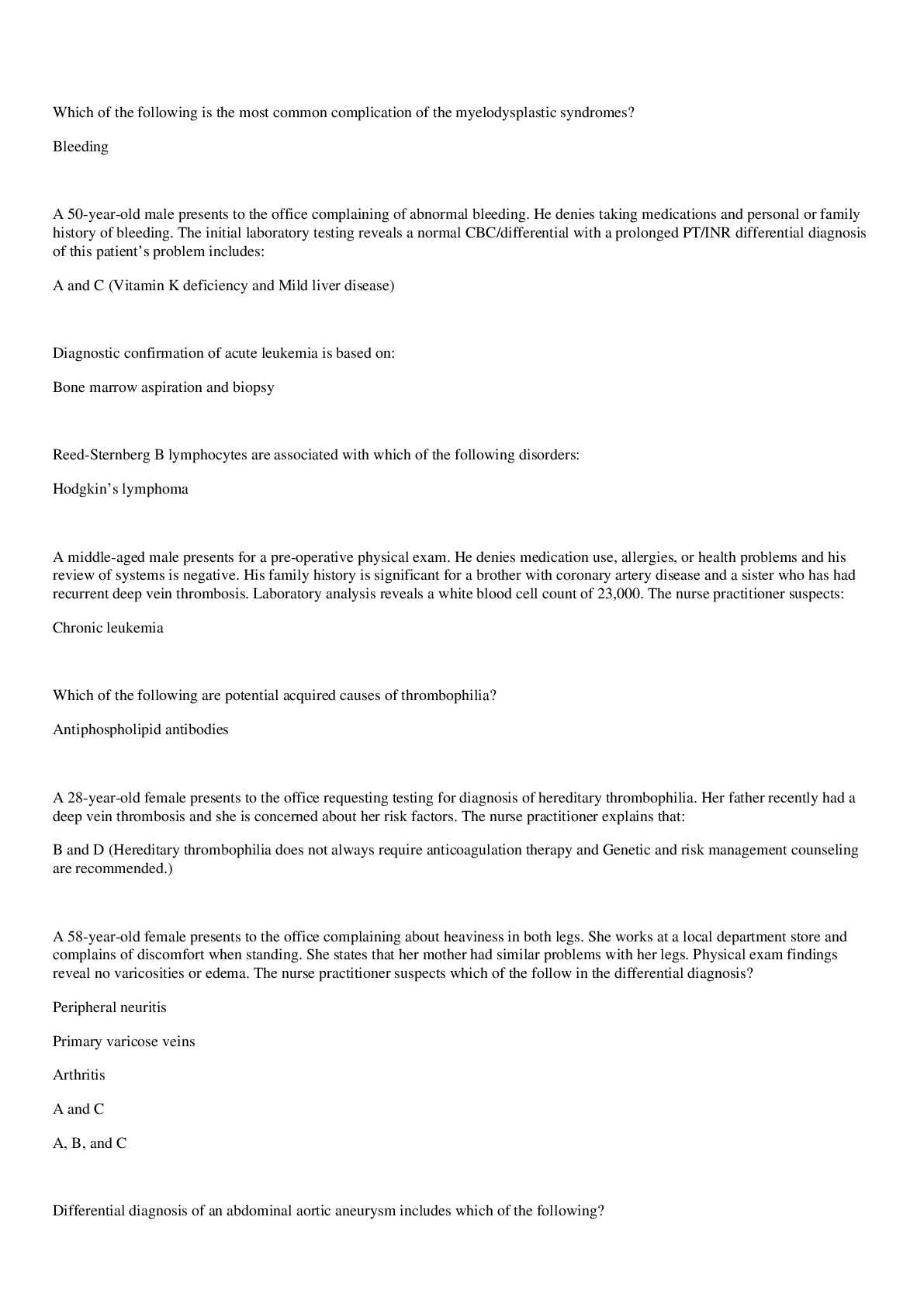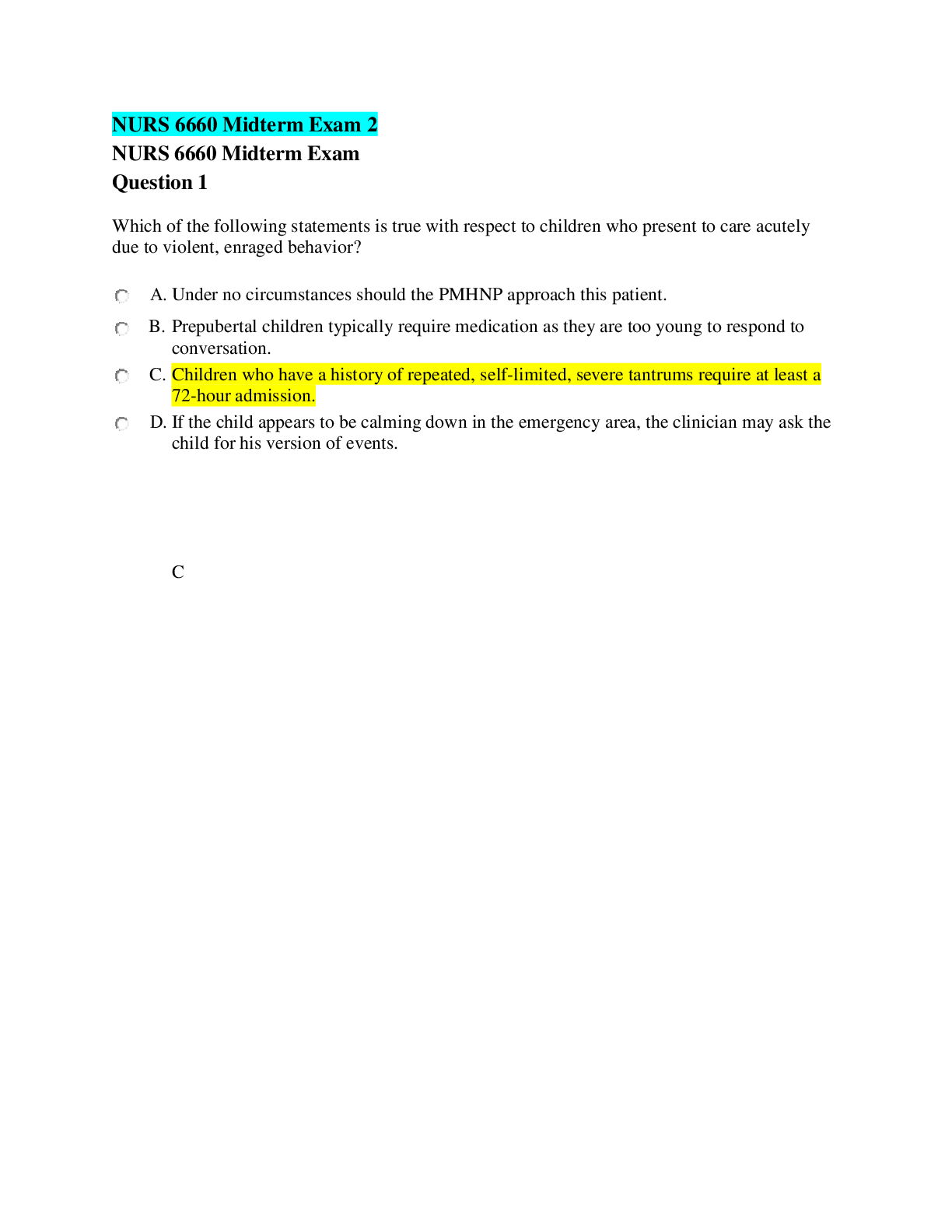NURS 6531 Week 4 Quiz | Advance Practice Care of Adults; Complete Answers.
Document Content and Description Below
Week 4 Quiz NURS 6531 1. Which of the following is the most common complication of the myelodysplastic syndromes? 2. A 50-year-old male presents to the office complaining of abnormal bleeding. ... He denies taking medications and personal or family history of bleeding. The initial laboratory testing reveals a normal CBC/differential with a prolonged PT/INR differential diagnosis of this patient’s problem includes: 3. Diagnostic confirmation of acute leukemia is based on: 4. Reed-Sternberg B lymphocytes are associated with which of the following disorders: 5. A middle-aged male presents for a pre-operative physical exam. He denies medication use, allergies, or health problems and his review of systems is negative. His family history is significant for a brother with coronary artery disease and a sister who has had recurrent deep vein thrombosis. Laboratory analysis reveals a white blood cell count of 23,000. The nurse practitioner suspects: 6. Which of the following are potential acquired causes of thrombophilia? 7. A 28-year-old female presents to the office requesting testing for diagnosis of hereditary thrombophilia. Her father recently had a deep vein thrombosis and she is concerned about her risk factors. The nurse practitioner explains that: 8. A 58-year-old female presents to the office complaining about heaviness in both legs. She works at a local department store and complains of discomfort when standing. She states that her mother had similar problems with her legs. Physical exam findings reveal no varicosities or edema. The nurse practitioner suspects which of the follow in the differential diagnosis? 9. Differential diagnosis of an abdominal aortic aneurysm includes which of the following? 10. Which of the following are essential components of the vascular physical exam? 11. Clinical diagnosis of an aortic aneurysm is suspected when the aorta is: 12. Diastolic murmurs are caused by regurgitation across the: a. 13. A 57-year-old male presents to urgent care complaining of substernal chest discomfort for the past hour. The EKG reveals ST elevations in Leads II, III, and AVF. The nurse practitioner is aware that these changes are consistent with which myocardial infarction territory? 14. During the physical examination, the nurse practitioner notes the presence of an S4 gallop. The nurse practitioner realizes that an S4 occurs: 15. Which of the following patient symptoms is consistent with an acute myocardial infarction? 16. Which of the following disorders is associated with genetic cardiovascular disease? 17. Which of the following is not a risk factor for development of an abdominal aortic aneurysm? 18. Which of the following physical exam findings suggests the presence of heart failure? 19. Which of the following disorders are associated with primary hypertension? 20. An 88-year-old female presents complaining of “liquid” draining from her leg. She denies pain or injury. The physical exam reveals an irregularly shaped shallow ulceration on the posterior left lower extremity above the ankle. An area of warmth and erythema surround the lesion. The nurse practitioner suspects: [Show More]
Last updated: 6 months ago
Preview 1 out of 3 pages

Buy this document to get the full access instantly
Instant Download Access after purchase
Buy NowInstant download
We Accept:

Reviews( 0 )
$6.00
Can't find what you want? Try our AI powered Search
Document information
Connected school, study & course
About the document
Uploaded On
Feb 01, 2020
Number of pages
3
Written in
Additional information
This document has been written for:
Uploaded
Feb 01, 2020
Downloads
0
Views
220


























